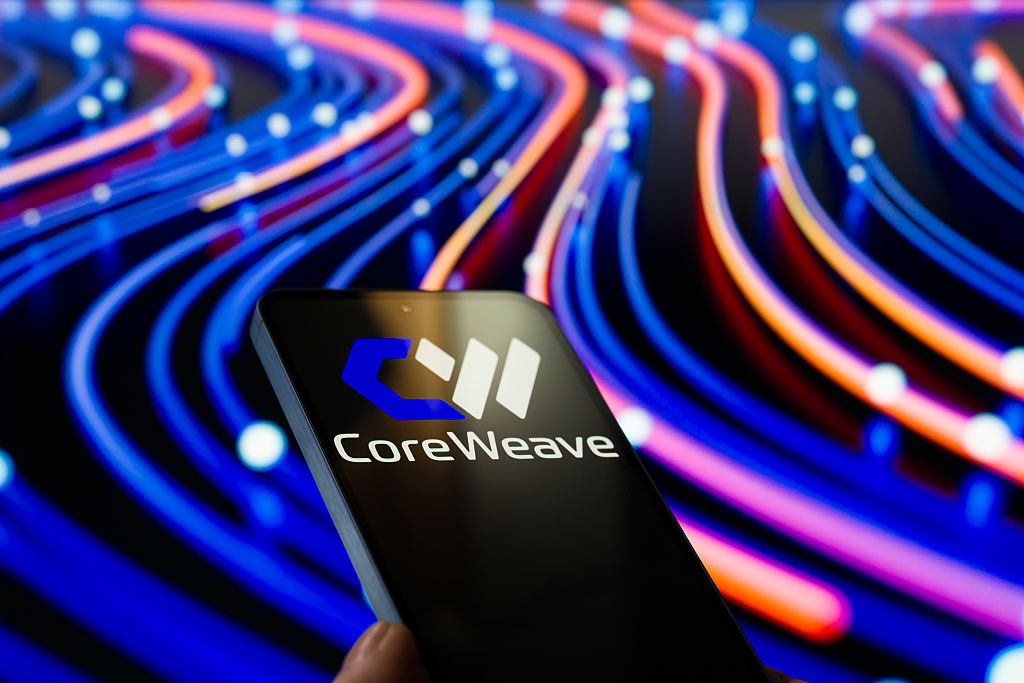Is the AI boom a bubble – and will it burst?
Massive spending on AI infrastructure is starting to spook investors, but experts say the bubble doesn’t look like bursting yet


Artificial intelligence (AI) megacap stocks have soaked up much of the stock market’s gains over recent years.
We’ve become used to the AI megacaps being the top stocks for investors, but top bankers from the likes of Morgan Stanley, JP Morgan and Goldman Sachs have voiced their concerns that AI stocks’ valuations are reaching bubble-like levels.
In November, a regulatory filing revealed that legendary contrarian investor Michael Burry – famously portrayed by Christian Bale in The Big Short – had allocated over 80% of his fund to bets against Nvidia (NASDAQ:NVDA) and Palantir (NASDAQ:PLTR). It later emerged that he had closed his hedge fund, saying in a statement: “My estimation of value in securities is not now, and has not been for some time, in sync with the markets.”
MoneyWeek
Subscribe to MoneyWeek today and get your first six magazine issues absolutely FREE

Sign up to Money Morning
Don't miss the latest investment and personal finances news, market analysis, plus money-saving tips with our free twice-daily newsletter
Don't miss the latest investment and personal finances news, market analysis, plus money-saving tips with our free twice-daily newsletter
Nvidia’s earnings beat in the same month ended up spooking the markets: Nvidia had made so much money, investors apparently wondered how long its customers could afford it. Shares in Oracle (NASDAQ:ORCL) then fell 12.6% overnight following its 10 December earnings release which fed capex overspend fears.
“Markets quickly looked past the massive earnings beat, driven by a one-off asset sale, and focused on the rising capex and weak cash flows,” said Matt Britzman, senior equity analyst at Hargreaves Lansdown. “Oracle has been at the epicentre of the AI financing debate, lacking the mammoth cash flows of the more traditional cloud giants.”
But some experts think it is too soon to worry about the scale of AI capex spend.
“The AI capex boom will likely create excesses, but neither its size nor its leverage is extreme,” said Henry Wu, chief quantitative strategist at Alpine Macro.
So is the AI boom market a bubble? Or is there still more value for investors?
Is AI a bubble?
The tricky thing about stock market bubbles is that they can only be definitively identified in retrospect.
“As AI adoption accelerates at unprecedented speed, investors are questioning whether today’s boom is laying the foundations for long-term growth, or inflating the next major market bubble,” said Ian Mortimer, co-portfolio manager of the Guinness Global Equity Income fund.
Doubts over the economics of current capex spend are being weighed against optimism over the long-term potential of AI.
“Despite bubble fears, early evidence shows AI is already improving business outcomes across major platforms including Meta, Microsoft, and Amazon,” said Mortimer. “Compared with previous market bubbles, today’s leading tech firms maintain strong margins, robust balance sheets, and reasonable valuations, with the Magnificent 7 trading well below the extremes of the dotcom era or Japan’s 1980s boom.”
What did for the dotcom boom was unprofitable companies borrowing money that, ultimately, they were never able to pay back. While the use of debt to fund AI investments is creeping up, lenders don’t appear concerned at present.
“Corporate bond markets – often the first to spot trouble – remain calm, with credit spreads close to record lows,” said Felise Agranoff, portfolio manager of JPMorgan American Investment Trust.
And while the stock market has ballooned on the back of AI exuberance, this appears to be backed up by financial performance.
“Despite soaring share prices, earnings have broadly kept pace, and the Morningstar Global Next Generation AI Index is currently trading close to fair value,” said Kenneth Lamont, principal at Morningstar.
Protecting against the AI bubble bursting
That doesn’t mean that bubble talk is misplaced, or that a major correction could wipe billions of value off stock markets.
“Announced mega-scale infrastructure programmes imply collective capital expenditure that could dwarf even the most capex-hungry industries, such as oil and gas,” said Lamont. “If data-centre assets fail to deliver their assumed useful lives, or if projections for the profitability of AI applications disappoint, today’s enormous spending plans could quickly become a millstone around the neck.”
You are likely more exposed to any potential bursting of the AI megacap bubble than you think. Most of your portfolio, whether that’s investments in a stocks and shares ISA or your pension, will likely comprise index funds that track the global stock market. If sentiment towards these stocks dips, your portfolio could take a hit, at least in the short run. This concentration risk is one of the drawbacks of passive investing.
You can reduce your concentration risk by buying equal-weight funds, which will cap every holding at a certain weighting of the portfolio. Lamont highlights Xtrackers S&P 500 Equal Weight UCITS ETF (LON:XDWE) as an example.
Or alternatively, you could buy a fund that excludes the megacaps altogether, such as Amundi MSCI USA Ex Mega Cap UCITS ETF (LON:XMGA).
Investors that want to retain some exposure to AI without being over-exposed to the stretched valuations of the megacaps could look for value opportunities in AI and its broader ecosystem, such as the suppliers to companies like Nvidia.
Rob Morgan, chief investment analyst at Charles Stanley, emphasises that diversification is the key to protecting your portfolio against market volatility.
“In today’s context, investors should ensure their portfolios aren’t completely dominated by the theme of big tech and AI, including tracker funds heavily skewed towards large US stocks,” he said.
Morgan recommends bonds as one offset to big tech concentration as well as defensively-minded global equity funds, or equity funds that target resilient, dividend-paying stocks. He highlighted JO Hambro Global Opportunities and Trojan Global Income as two quality-focused funds for investors to consider.
Bear in mind, also, that there are risks to being under-invested during a stock market boom. The table below shows how £10,000 invested into the S&P 500 in various years leading up to the dotcom crash fared compared to the same investment into a safe money market fund in the same year.
Investment period | Value of £10,000 invested | Value of £10,000 invested |
|---|---|---|
| Row 0 - Cell 0 | S&P 500 | Money Market Fund |
Dec 1994 to Dec 2005 | £28,909 | £14,891 |
Dec 1995 to Dec 2005 | £20,854 | £14,310 |
Dec 1996 to Dec 2005 | £18,693 | £13,729 |
Dec 1997 to Dec 2005 | £13,477 | £13,109 |
Dec 1998 to Dec 2005 | £10,599 | £12,428 |
Dec 1999 to Dec 2005 | £8,514 | £11,965 |
Source: AJ Bell and FE, total return in GBP from S&P 500 and IA Standard Money Market fund sector average (31st December to 31st December)
“The numbers show that investing in the market in December 1994, 1995, 1996 and 1997 was still preferable to investing in a money market fund, if you held on until the end of 2005, despite the market crash that was coming,” says Laith Khalaf, head of investment analysis at AJ Bell. “Investing in the money market fund was the better course of action in December 1998 and 1999, in the later stages of the bubble.”
Get the latest financial news, insights and expert analysis from our award-winning MoneyWeek team, to help you understand what really matters when it comes to your finances.

Dan is a financial journalist who, prior to joining MoneyWeek, spent five years writing for OPTO, an investment magazine focused on growth and technology stocks, ETFs and thematic investing.
Before becoming a writer, Dan spent six years working in talent acquisition in the tech sector, including for credit scoring start-up ClearScore where he first developed an interest in personal finance.
Dan studied Social Anthropology and Management at Sidney Sussex College and the Judge Business School, Cambridge University. Outside finance, he also enjoys travel writing, and has edited two published travel books.
-
 Goodwin: A superlative British manufacturer to buy now
Goodwin: A superlative British manufacturer to buy nowVeteran engineering group Goodwin has created a new profit engine. But following its tremendous run, can investors still afford the shares?
-
 Is US stock market exceptionalism over?
Is US stock market exceptionalism over?US stocks trailed the rest of the world in 2025. Is this a sign that a long-overdue shift is underway?
-
 Metals and AI power emerging markets
Metals and AI power emerging marketsThis year’s big emerging market winners have tended to offer exposure to one of 2025’s two winning trends – AI-focused tech and the global metals rally
-
 Quality emerging market companies with consistent returns
Quality emerging market companies with consistent returnsOpinion Mark Hammonds, portfolio manager at Guinness Global Investors, selects three emerging market stocks where he'd put his money
-
 Coreweave is on borrowed time
Coreweave is on borrowed timeAI infrastructure firm Coreweave is heading for trouble and is absurdly pricey, says Matthew Partridge
-
 An AI bust could hit private credit – could it cause a financial crisis?
An AI bust could hit private credit – could it cause a financial crisis?Opinion Private credit is playing a key role in funding data centres. It may be the first to take the hit if the AI boom ends, says Cris Sholto Heaton
-
 The top stocks of 2025 - did you pick a winner?
The top stocks of 2025 - did you pick a winner?As a chaotic year in the stock market draws to a close, we review which stocks were investors’ top picks for 2025
-
 Why Trustpilot is a stock to watch for exposure to the e-commerce market
Why Trustpilot is a stock to watch for exposure to the e-commerce marketTrustpilot has built a defensible position in one of the most critical areas of the internet: the infrastructure of trust, says Jamie Ward
-
 Which sectors are best to invest in for 2026?
Which sectors are best to invest in for 2026?Investment trust portfolio managers give their views on the sectors and regions they expect to outperform in 2026.
-
 ChatGPT turns three: what’s next for the ‘AI era’?
ChatGPT turns three: what’s next for the ‘AI era’?Three years after its launch kickstarted the age of AI, ChatGPT and its maker OpenAI are driving the stock market. But concerns are growing over whether OpenAI will be able to turn its AI dominance into profit.